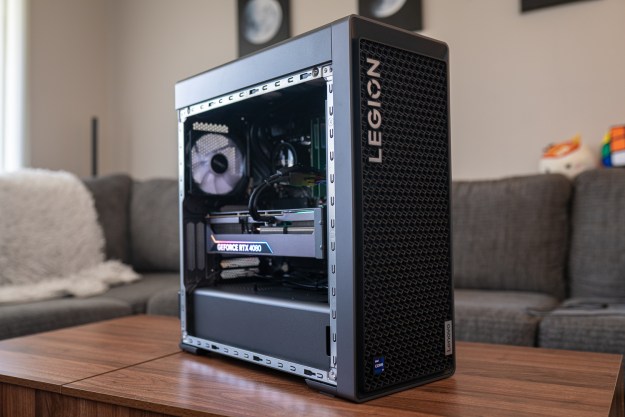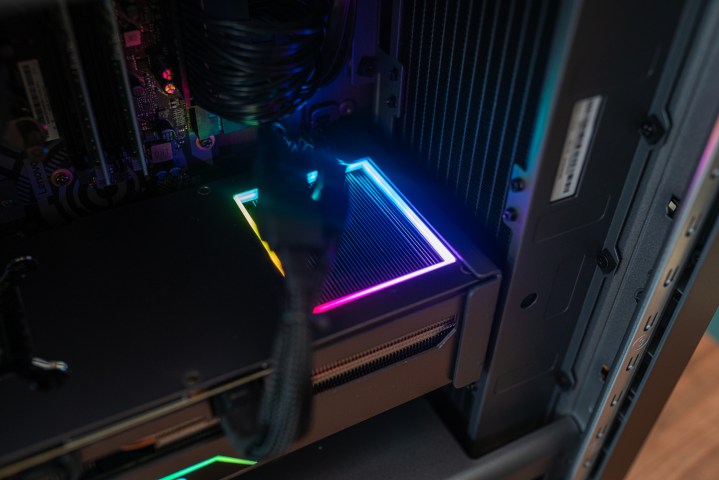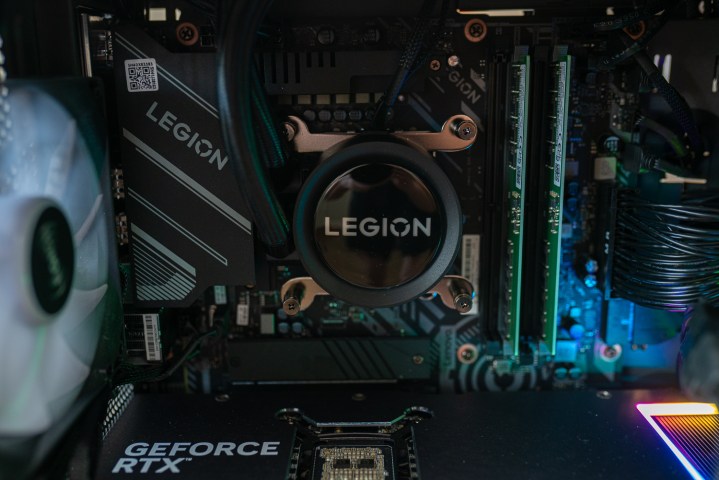
“The Lenovo Legion Tower 7i makes one big mistake, but it gets almost everything else right.”
- Flagship 4K gaming performance
- Support for DLSS 3
- Fully upgradable
- Sleek, attractive design
- RAM runs at slower speed
- McAfee continues to annoy
It can be hard to find a good value when searching for the best gaming desktops, but the Lenovo Legion Tower 7i hits that mark. It’s still expensive at over $3,000, but it offers flagship components and performance for less than the competition.
Combined with a stylish design and standard component sizes, the Tower 7i feels like an investment you can carry far into the future — despite a lingering issue I ran into with memory speed.
Lenovo Legion Tower 7i specs

The Lenovo Legion Tower 7i comes with some significant upgrades over the previous generation. Unsurprisingly, it moves from Nvidia RTX 30-series GPUs to the RTX 40-series, as well as from 12th-gen to 13th-gen Intel processors. But Lenovo also bumped up the processor class to Intel’s Core i9 tier, which is paired with an RTX 4080 graphics card.
This is the only model currently available, but I imagine Lenovo will offer cheaper configurations in the future. For the GPU, Lenovo moved from the RTX 3080 to the RTX 4080, which sounds like a straight move, but it’s not — although the RTX 4080 and RTX 3080 are in the same class based on Nvidia’s naming, the newer is GPU is around $500 more expensive.
| CPU | Intel Core i9-13900KF |
| GPU | Nvidia RTX 4080 |
| Motherboard | ATX Lenovo motherboard |
| Case | Custom Lenovo Legion Tower case |
| Memory | 32GB DDR5-5600 (2 x 16GB) |
| Storage | 1TB NVMe SSD |
| Power supply | Custom Lenovo 850W PSU |
| USB ports | 7x USB 3.2, 4x USB 2.0, 1x USB-C 3.2 Gen 2 |
| Networking | 2.5G Ethernet, Wi-Fi 6E, Bluetooth 5.1 |
| Price | $3,350 |
Unsurprisingly, that means the Lenovo Legion Tower 7i is more expensive as a result. What used to be a desktop that topped out around $2,100 now goes for $3,350. You get a much more capable GPU, as well as a big bump to the CPU. However, I would have liked to have seen an option for Intel’s Core i7-13700KF, saving some money without changing much about gaming performance.
The Lenovo Legion Tower 7i may be more expensive than the previous generation, but it’s still not overpriced. A similarly configured Alienware Aurora R15 runs $600 more than the Tower 7i. The MSI Aegis RS 13 is around $300 cheaper, but it has a slightly weaker processor. It’s important to remember that last-gen desktops are still selling for quite a bit, too. The Asus ROG Strix GA35 with an RTX 3090 and Ryzen 9 5900X is around the same price as the Tower 7i.
All of that is to say: the Legion Tower 7i is more expensive than the last generation, but it’s not unreasonably priced.
Understated with sparks of flair

Prebuilt gaming desktops haven’t caught up to a custom-built PC in terms of design, unless you opt for an expensive, boutique option like the Falcon Northwest Tiki or Origin Neuron. The Tower 7i is a breath of fresh air because it’s simple.
You’re getting a standard mid-tower design, which is elevated by some subtle curving around the edges. The sandblasted finish feels classy, and you get a full view into the machine with the tempered glass side panel.

It’s not over-the-top when it comes to RGB, either. If anything, the Tower 7i could use a little extra lighting. The only RGB lighting comes from the logo on the GPU, as well as a really nice cutout on the back shield of the GPU. It lights up and illuminates the heatsink, and it looks fantastic. Frankly, I’m bummed Lenovo doesn’t sell this as a separate GPU.
Unfortunately, that attractive lighting is lost is a sea of nothingness. A couple of RGB fans would go a long way toward making the Tower 7i feel more cohesive. As it stands now, the attractive GPU stands out in a way I don’t think Lenovo intended. The good news is that you’re free to swap out the fans if you want, so you can add a little more flair to the build.
Open for upgrades

Nothing hinders you from upgrading the Tower 7i, and if anything, Lenovo encourages you to expand on the current design. The case is a standard mid-tower, not dissimilar from many of the chassis you’d find on our list of the best PC cases. And that’s a good thing if you plan on upgrading your PC in the future.
For components, everything is standard in the Tower 7i, so you’re free to swap components out, including the motherboard. The case also has two drive sleds in the basement and two mounts for SSD in the back of the case. Even better, Lenovo has SATA connections prerouted to the drive sleds so you can easily expand your storage.

Airflow through the case is solid, with the radiator in the front serving as intakes, while two 120mm in the top and one in the rear are on exhaust duty. Even under a strenuous Cinebench load, the PC didn’t get too loud (at least not any more loud than a custom-built machine).
Unlike the HP Omen 45L, the Tower 7i isn’t tool-less. There are a couple of captive thumbscrews on both of the side panels, but that’s all you need to undo to get into the machine. I’ll take that over the proprietary components and needless brackets inside machines like the Aurora R15 and ROG GA53.
Limited CPU potential
The Core i9-13900KF at the heart of the Legion Tower 7i is one of the best processors you can buy. As you can read in our Core i9-13900K review, it tops the charts in most productivity tasks, and the Tower 7i shows off the processor in a good light (at least in our benchmarks). But I have some concerns about its usefulness in all tasks.
| Lenovo Legion Tower 7i (Core i9-13900KF) | Alienware Aurora R15 (Core i9-13900KF) | HP Omen 45L (Core i9-12900K) | |
| Cinebench R23 Multi-Core | 36,783 | 34,3211 | 23,068 |
| Cinebench R23 Single-Core | 2,171 | 2,171 | 1,893 |
| Geekbench 5 Multi-Core | 21,742 | 21,535 | 15,685 |
| Geekbench 5 Single-Core | 2,095 | 2,113 | 1,910 |
| PugetBench for Premiere Pro | 1,242 | 1,309 | 1,025 |
| Blender Monster (GPU) | 4,913 | 6,501 | N/A |
| Blender Junkshop (GPU) | 2,415 | 3,049 | N/A |
| Blender Classroom (GPU) | 2,309 | 3,119 | N/A |
That’s because of RAM speed, not the processor itself. Lenovo advertises that the Legion Tower 7i comes with 5,600 megatransfers per second (MT/s) memory, and that’s true, but the memory only runs at 4,400 MT/s. I was able to confirm the memory is validated for the higher speed, so it’s bizarre that Lenovo doesn’t have that speed enabled out of the box.
Memory speed doesn’t always matter — my benchmarks above are a testament to that — but the slower speed out of the box could mean that the Tower 7i is leaving extra performance on the table in certain tasks.

For my benchmarks, the Core i9-13900KF still ran well. It’s a 24-core behemoth that tops the charts in synthetic benchmarks like Cinebench and Geekbench, even outpacing the same model in the Alienware Aurora R15. It took a back seat in Premiere Pro, but that’s due to the slower GPU inside the Lenovo machine.
Even with fantastic CPU performance, I wish there was a cheaper option. As mentioned above, a chip like the Core i7-13700KF would shave some money off the price while offering similar (or identical) gaming performance. Hopefully, we’ll see cheaper configurations in the future.
Full RTX 4080 power

Even with slower RAM, the Tower 7i doesn’t hinder your gaming performance. The RTX 4080 is able to fully stretch its legs, matching and sometimes even outpacing the results we gathered in our RTX 4080 review.
| Lenovo Legion Tower 7i (RTX 4080) | Alienware Aurora R15 (RTX 4090) | Custom RTX 4080 desktop (Ryzen 9 7950X) | |
| Cyberpunk 2077 (4K Ultra) | 62 fps | 83.2 fps | 58.9 fps |
| Cyberpunk 2077 (4K Ultra RT) | 29 fps | 43.1 fps | 29 fps |
| Red Dead Redemption 2 (4K Ultra) | 97 fps | 127.3 fps | 97.2 fps |
| Forza Horizon 5 (4K Ultra) | 136 fps | 151.9 fps | 133.7 fps |
| Assassin’s Creed Valhalla (4K Ultra High) | 100 fps | 120.4 fps | 98.4 fps |
| Gears Tactics (4K Ultra) | 108 fps | 136.9 fps | 103.8 fps |
| 3DMark Time Spy | 24,554 | 29,597 | 25,402 |
The RTX 4090 inside the Alienware Aurora R15 is more powerful, but make no mistake, the RTX 4080 is still a powerful 4K graphics card. Across my test suite, including Cyberpunk 2077 with everything maxed out, the GPU averaged above 60 frames per second (fps) at 4K.
Still, an RTX 4090 model for those who have extra money to burn would be nice to see. It gets into a different class of performance, sometimes offering upwards of a 27% increase in performance as showcased by Gears Tactics.
However, you get access to a great feature with any RTX 40-series GPU: Deep Learning Super Sampling (DLSS). All RTX GPUs have access to DLSS, but the most recent generation can also leverage DLSS Frame Generation.
| Lenovo Legion Tower 7i (RTX 4080) | |
| Cyberpunk 2077 4K Ultra RT | 29 fps |
| Cyberpunk 2077 4K Ultra RT w/ DLSS 3 | 115 fps |
Read our RTX 4090 review for a full breakdown of DLSS 3, but you can get a taste of what it offers above. With Cyberpunk 2077’s 4K Ultra RT preset, the Legion Tower 7i went from 29 fps to 115 fps — nearly a 300% increase. That’s insane, and it’s all possible due to DLSS 3.
McAfee strikes
Lenovo includes a suite of preinstalled software on the machine. You’ll mainly interact with Lenovo Vantage, which includes GPU and CPU monitoring tools, along with lighting adjustments. For updates and support, there’s Lenovo Welcome, and for launching your games, there’s Lenovo Arena. That’s not a problem, though I could do without Arena.
Otherwise, there’s a Steelseries utility for managing your audio and McAfee. Preinstalled antivirus programs are always annoying, but McAfee takes the cake in pop-up ads. Nearly every time I booted the machine, a notification would pop up, telling me my computer is at risk and I need to renew my subscription. The Tower 7i includes a month of McAfee Live Safe for free, but after 30 days, you’ll see the same notifications.
It’s notoriously difficult to uninstall McAfee, but it can be done. Although the inclusion is annoying, Lenovo is far from the only brand to bundle antivirus adware on prebuilt gaming desktops, so it’s tough to fault the Tower 7i.
Should you buy the Lenovo Legion Tower 7i?

The Lenovo Legion Tower 7i is one of the most impressive prebuilt gaming desktops I’ve looked at. It performs well and comes with an attractive, understated design, and it’s fully open for upgrades in the future, showing a level of foresight that few brands match.
The main issue is the RAM configuration, potentially limiting the the performance of the machine when it doesn’t need to. I didn’t see any issues in my testing, but memory-sensitive tasks can suffer. Thankfully, you can boost the memory speed manually, so this is a solvable issue.
Editors' Recommendations
- Best gaming PC deals: Lenovo Legion, ASUS ROG, Acer Predator
- Lenovo just made my favorite gaming laptop even better
- Lenovo’s Legion Glasses promise big-screen gaming wherever you are
- Flex your GPU’s power with the best ray tracing PC games
- Lenovo Legion 7 hands-on review: Power stands out





